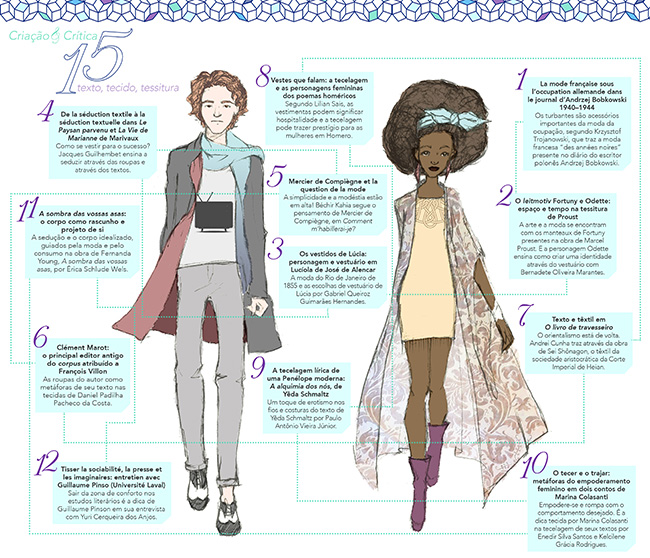Mercier de Compiègne and the question of fashion
DOI:
https://doi.org/10.11606/issn.1984-1124.v0i15p74-86Keywords:
Mercier de Compiègne, fashion, woman, nature, national costumeAbstract
The fashion in Paris at the XVIIIth century knows deep changes. The clothing offer is illustrated by a fashion periodic press which is renews its proposals thanks to attractive engravings. Especially an iconic figure emerges from this Age of Lumières: the fashion trader and his most famous representing, Miss Rose Bertin, “minister of fashion” of the queen of France, Marie-Antoinette. The women were as funny birds which change plumage two or three times a day. The women passion for fashion caused strong reactions, especially those of Mercier de Compiègne. In Comment m’habillerai-je ? Mercier established an undeniable link between the clothing fashion and the power of nation. The respect of simplicity, reflects reserve and modesty; two virtues characteristic of the human nature. Any clothing which can excite the claims of the women is against their natural destination. Mercier sings the return to nature. The author of Comment m’habillerai-je ? exalts the transparent and natural beauty image. These reflections want to allure the royal court and to change the rules of good taste.Downloads
References
BARTHES Roland, « Histoire et sociologie du vêtement », Annales Économies-Sociétés-Civilisations, vol. 12, N°3, Paris, Colin, 1957, p. 430-441.
CLINTON Katherine, « Femme et philosophe: Enlightenment origins of feminism », Eighteenth Century Studies, vol. 8, No3, 1975, p. 283-299.
DE LA BRETONNE Rétif, Les Nuits de Paris : La semaine nocturne, vingt nuits de Paris, [1788-1794]. Éd. d’Aujourd’hui, Le Plan-de-la-Tour, 1978.
DELAPIERRE Madeleine, Se vêtir au XVIIIe siècle, Paris, Adam Brio, 1996.
DEVOCELLE Jean-Marc, « D’un costume politique à une politique du costume. Approches théoriques et idéologiques du costume pendant la Révolution française », in Modes et Révolutions 1780-1804, Paris, Éd. Paris-Musées, 1989, p. 83-103.
FORTASSIER Rose, Les écrivains français et la mode de Balzac à nos jours, Paris, PUF, 1988.
HOFFMANN Paul, La femme dans la pensée des Lumières, Paris, Ophrys, 1977.
KLEINERT Annemarie, « La mode, miroir de la Révolution française », in Modes et Révolutions 1780-1804, Éd. Paris-Musées, Paris, 1989, p. 59-81.
KNIBIEHLER Yvonne, « Les médecins des Lumières et la nature féminine », in 1789-1799 : combats de femmes, La Révolution exclut les citoyennes, (dir.) E. Morin-Rotureau, Paris, Éd Autrement, 2003, p. 127-142.
L’ISLE-ADAM Villiers (de), L’Eve future, édition établie par Pierre Citron, L’Age d’Homme, Lausanne, coll. « Romantiques », 1979.
MERCIER DE COMPIÈGNE Claude, Comment m’habillerai-je ? Réflexions politiques et philosophiques sur l’habillement français, et sur la nécessité d’un costume national, Paris, de l’imprimerie de l’auteur, 1793.
PERROT Philippe, Le travail des apparences ou les transformations du corps féminin XVIIIe-XIXe siècle, Paris, Seuil, 1984
SÉGUY Philippe, Histoire des modes sous l’Empire, Paris, Tallandier, 1988.
VITTU Françoise, « 1780-1804 ou vingt ans de Révolution des têtes françaises », in Modes et Révolutions 1780-1804, Paris, Éd. Paris-Musées, 1989, p. 41-57.
Downloads
Published
Issue
Section
License
Authors who publish with this journal agree to the following terms:
- Authors retain copyright and grant the journal right of first publication with the work simultaneously licensed under a Creative Commons Attribution License that allows others to share the work with an acknowledgment of the work's authorship and initial publication in this journal.
- Authors can enter into separate, additional contractual arrangements for the non-exclusive distribution of the journal's published version of the work (e.g., post it to an institutional repository or publish it in a book), with an acknowledgment of its initial publication in this journal.
- Authors are permitted and encouraged to post their work online (e.g., in institutional repositories or on their website) before and during the submission process, as it can lead to productive exchanges, as well as earlier and greater citation of published work (See The Effect of Open Access).



